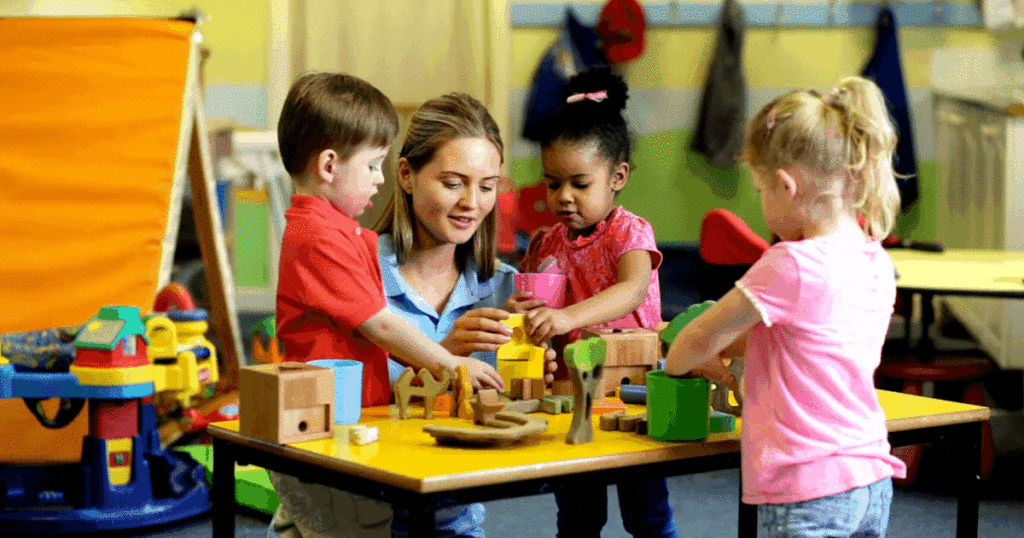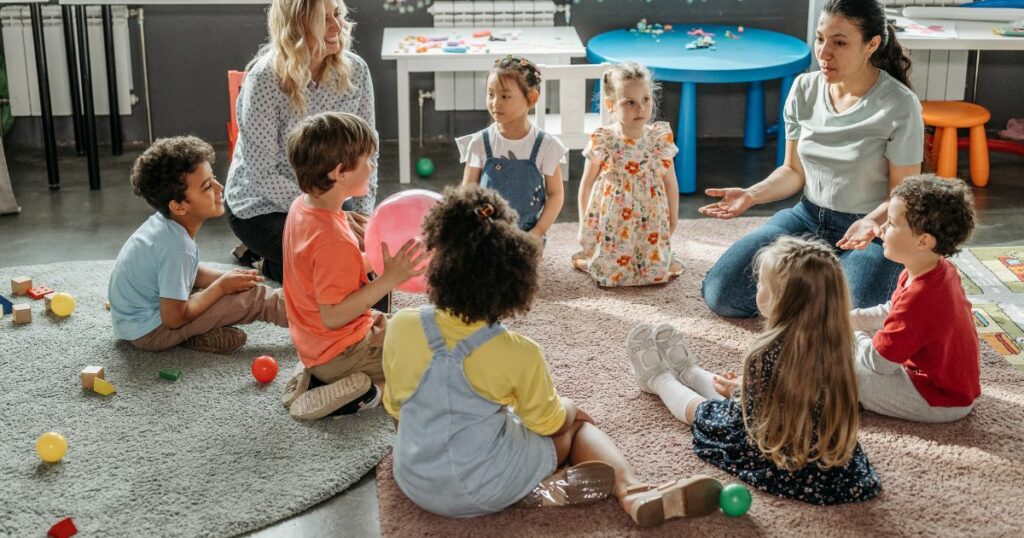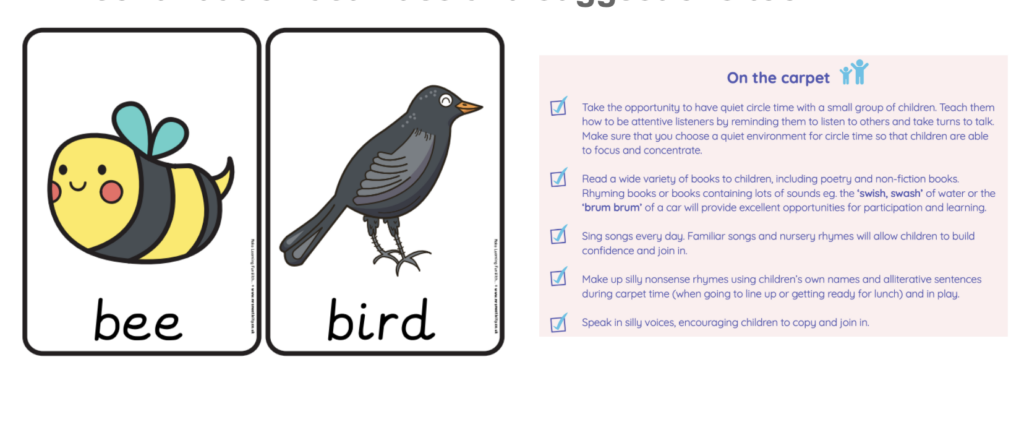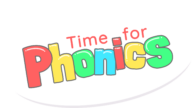A grasp of phase 1 phonics is absolutely vital to ensure that children achieve success with reading. But why is it so often neglected? In this blog post, we tell you everything you need to know about phase 1 phonics including what phase 1 phonics is, why it’s so important, and explore our own phase 1 phonics scheme and how it can help your practice, your children and your setting.
What is phase 1 phonics?
Phase 1 is the first stage of phonics, and lays the foundation for future phonics learning. The primary focus is on developing speaking and listening skills to enable children to become ready for developing oral blending and segmenting skills. These skills are fundamental for effective communication and language development, as children learn to distinguish and produce different sounds, which is the basis for understanding and using language. Phase 1 phonics is taught across Nursery and Reception and focuses on the foundational listening skills that children will need to build upon in order to learn to read and later, write. Phase 1 doesn’t introduce any specific phonemes but instead covers key skills like differentiating between sounds and understanding rhythm and rhyme.
According to the DfE’s Letters and Sound document (2007), phase 1 activities are arranged under the following aspects:
- Aspect 1: General sound discrimination – environmental sounds
- Aspect 2: General sound discrimination – instrumental sounds
- Aspect 3: General sound discrimination – body percussion
- Aspect 4: Rhythm and rhyme
- Aspect 5: Alliteration
- Aspect 6: Voice sounds
- Aspect 7: Oral blending and segmenting
Each aspect is then divided into three strands.
- Tuning into sounds (auditory discrimination)
- Listening and remembering sounds (auditory memory and sequencing)
- Talking about sounds (developing vocabulary and language comprehension).
When is phase 1 covered?
Phase 1 is typically covered when children are aged 3-4, in the time before they start Reception, whilst some schools (and we recommend this on in our phase 1 phonics programme), choose to carry on phase 1 for a half term, or more, after children begin Reception. Phase 1 phonics can be covered by childminders, pre-schools, private nurseries, school nurseries and even at playgroups. Parents can of course, also expose children to phase 1 phonics at home through play and adult-led activities. So is the everything you need to know about phase 1 phonics – definitely not!

Why is phase 1 phonics so important?
The reason we’re so passionate about phase 1 is because…it:
- Lays the foundation for later letter learning and word reading
- Develops listening and understanding skills
- Encourages children to explore sounds around them, engaging with the natural world, musical instruments and their own bodies
- Learning through play, experimentation and exploration
- Develops skills in assigning meaning to different sounds
- Encourages children to expand their vocabulary
- Supports many areas of learning
- Continues to support subsequent phonics phases

What happens if you don’t cover phase 1?
If phase 1 has NOT been covered sufficiently and implemented effectively, these are some of the issues and problems you would typically find that children have when they start their phonics journey…
- Difficulty distinguishing between different sounds they hear
- Issues with listening and understanding skills
- Issues with attention & understanding skills – it may seem like they don’t hear you, or they won’t respond
- Delay in speaking skills
- Issues with identifying individual phonemes
- Difficulty recognising initial sounds in words
- Issues with blending for reading, and segmenting for writing
What to do if phase 1 hasn’t been covered
If you are a Reception teacher and you’re aware that not all of your new cohort have had exposure to phase 1 phonics – don’t panic! We’ve got you covered. Firstly, the obvious thing is simply to revisit phase 1, and we have a pre-created phase 1 phonics scheme of work that has everything done for you, it’s ideal for those who are new to phonics or those schools and settings looking for a structured approach where all children have equity when it comes to phonics instruction. Go back to basics, starting with listening skills then moving on to speaking skills. If only a few children are affected, consider streaming your children, covering our phase 1 phonics lessons, focusing specifically on oral blending and segmenting. You can also use our phonics intervention programme to help plug some of the gaps. You could also implement phase 1 in your continuous provision to give children as many opportunities as possible to develop these skills. Do NOT try to move on to reading – it will not work – if a child doesn’t have the foundation in phonics, they will not be able to access the learning in phase 2.
What are some examples of phase 1 phonics activities?
If you’re not following our phonics scheme, here are some easy activities that you could do as part of phase 1 phonics.
Phase 1, Aspect 1, Environmental Sounds
1. Take the children out into the grounds. Ask them to stop, and silently listen to what they can hear.
2. After 10 seconds or so, ask the children to recall the sounds they heard. You may like to comment on the sounds you heard
3. Walk to a different area of the grounds (or even outside the setting) and ask the children to listen again. Did you hear any of the same sounds? Are they louder or quieter now? Which different sounds did you hear?
Phase 1, Aspect 2, Instrumental Sounds
1. Show children a selection of instruments and then put them into a box (or hide behind a screen).
2. Adult to play one of the instruments. Encourage children to listen to the sound and guess which instrument it was. You can provide images of the instruments if you feel children may have trouble recalling their names.
3. Choose a child to come to the box and play one of the instruments. Other children must listen and guess the sound.
Phase 1, Aspect 3, Body Percussion
Faster, Slower
1. Gather children in a circle and ask them to stand up.
2. Instruct the children to stamp their feet by saying or singing, “Everybody stamp your feet.
3. Noticeably slow down your voice and say, “Stamp your feet ever so slowly.” Noticeably speed up your voice and say, “Stamp your feet ever so quickly!”
Repeat for different actions: clapping hands, waving arms, turning around, bending knees, patting head etc.
Phase 1, Aspect 7 Oral Blending and Segmenting
Cross the River
- Lay the piece of blue fabric on the floor to act as the river (or draw a river on the floor using blue chalk).
- Ask the children to sit on one side of the river and give each of them an object or card.
- Choose one of the objects or pictures and say its name out loud.
- The child with the object/card must show their card to the group and they blend and segment it in unison.
For example:
Teacher – “Coat.”
Children – “C-oa-t. Coat.”
- If the children find it difficult to orally segment the word, you may help them and ask them to immediately repeat after you.
- The child then crosses the river and sits at the other side.
- Repeat until all children have crossed the river.
- If you would like to play again, give each child a new card or object and repeat.

How can you cover phase 1 phonics play in provision?
Phase 1 phonics play can easily be incorporated into provision, some examples are:
Exploring objects/materials and the sounds they make
- Provide a variety of materials such as cardboard, plastic, metal, natural resources (sticks etc) and allow children to explore what sounds they can make with them
- This encourages children to experiment and is open ended – there are so many possibilities!
- Provision you can refresh with different materials
Books
Don’t forget about your books! Provide books that encourage children to explore sound: Animal noises, rhyming words, action stories (clapping, stamping etc).
Voice buttons/cards/talking tins
Record yourself sounding out a word that matches an object on the table. Children listen to the recording and match it to the object. For example,”d-u-ck” or “Find the animal that starts with d”.
Role Play
Place tins in the home corner with different foods inside. Tape them closed! Children can shake these while playing in the home corner and try to guess what is inside.
How does phase 1 phonics link to the EYFS?
Phase 1 creates a solid foundation for word reading later. It also supports other areas, such as:
- Listening and Understanding – paying attention to detail and assigning meaning
- Speaking – using new vocabulary learnt
- Writing – being able to segment and blend when trying to spell words
- The Natural World – observing different sounds and making links
- Being Imaginative and Expressive – signing songs, exploring sounds
By the end of the Reception year, we can still see elements of phase 1 in the Early Learning Goals:
- Speaking: ‘using recently introduced vocabulary’
- Being imaginative & expressive: sing a range of well-known nursery rhymes and songs
What is a good phase 1 phonics scheme
Us! Yes, we have a full scheme of planning for phase 1, including accompanying resources, and continuation activities and suggestions too. You can even take out a phase 1 ONLY phonics scheme membership, in case you don’t need the rest of the scheme.

Phase 1 phonics training video
We have told you everything you need to know about phase 1 phonics, but if you’re interested in finding out more about phase 1, you can watch our webinar: Why is phase 1 so important for phonics learning? – below!


